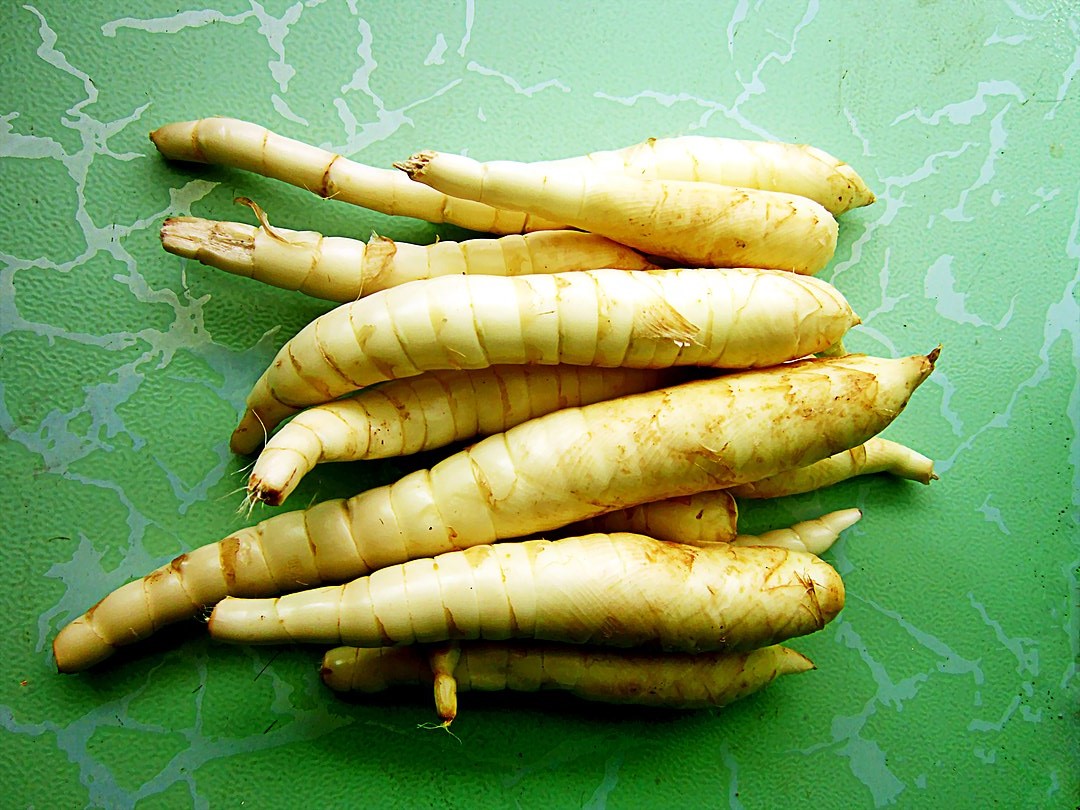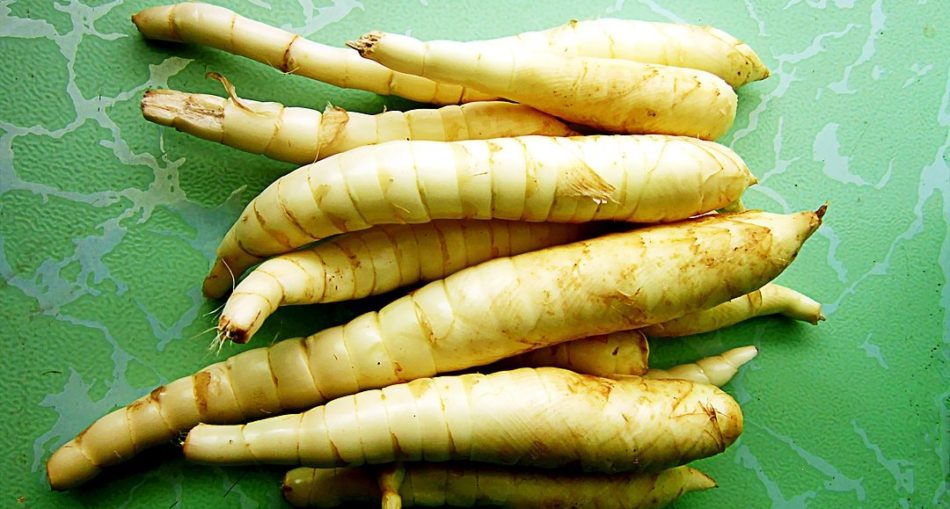Arrowroot was among the first plants in South America which were harvested for food. There is evidence supported by archaeological studies which show that Arrowroot has been cultivated in the Americas since seven thousand (7000) years ago! The name Arrowroot may have originated from the Arawak word ‘aru-aru‘ which means ‘meal of meals’ since it is a staple in the diet of this indigenous tribe. It is also believed it was named after its use on poison-arrow wounds, which is applied to the site or ‘root’ of the wound. Arrowroot is known by several names including the Bermuda arrowroot, West Indian arrowroot, maranta, obedience plant, araru, maranta, ararao, araruta and hulankeeriya. However, the scientific name is Maranta arundinaceai.
While not one of the most widely known tubers, like cassava, carrots and potatoes, Arrowroot has just as many benefits and uses. To date, the tuber remains one of the most versatile plants. It is most sought-after when made into the Arrowroot powder, which is added to dishes. Read on to find out seventeen (17) secret uses of Arrowroot and all its health benefits!

Arrowroot – Photo By Bùi Thụy Đào Nguyên – Own work, CC BY-SA 3.0, https://commons.wikimedia.org/w/index.php?curid=30026323
Origin of Arrowroot
Arrowroot is native to the Central America and Mexico, South America including Guyana, Brazil, Peru, Venezuela, French Guiana and the West Indies in Cuba Trinidad, Puerto Rico and Hispaniola. However, it is also grown in many parts of Asia like Sri Lanka, India, China, Indonesia, Equatorial Guinea, Mauritius, and the Phillipines.
Interesting Tip
- St. Vincent and the Grenadines is the largest producer of arrowroot and arrowroot flour in the world!
Description of Arrowroot
Arrowroot, like cassava, is a perennial plant but with a thin stem, forked at the apex. The leaves are radical and sheathed at the base, with a pulvinus, covered in thicken or sparse hair. There is often no petiole in the upper leave, which are ovate to oblong and rounding at the base. They are typically green in colour but sometimes streaked with brown, purple or white, having parallel veins. The herb is erect but is not rooted very deep into the soil. However, its rhizomes (edible parts of the plant) are grown deep underground. The rhizomes are the cylindrical, fleshy parts of the plant, either reddish in colour or white. Rhizomes are typically covered in overlapping deciduous brownish-white scale leaves. After about ninety (90) days of being planted, twin clusters of small white flowers are produced. While the plant produces seeds, however rarely, reproduction is typically by planting a part of the rhizome and a bud. The fruits of the Arrowroot plants are oblong and seven (7) mm long. They are brown and leathery while their seeds have three sides and pink with two-lobed, yellow basal aril.
Scientific Classification of Arrowroot
- Kingdom: Plantae
- Clade: Tracheophytes
- Clade: Angiosperms
- Clade: Monocots
- Clade: Commelinids
- Order: Zingiberales
- Family: Marantaceae
- Genus: Maranta
- Species: M. arundinacea
Nutritional Value of Arrowroot
Each 120 g serving of Arrowroot contains:
- Calories: 78
- Carbs: 16 grams
- Fibre: 2 grams
- Protein: 5 grams
- Fat: 0 grams
- Folate: 102% of the Daily Value (DV)
- Phosphorus: 17% of the DV
- Iron: 15% of the DV
- Potassium: 11% of the DV
Health Benefits of Arrowroot
- Weight Loss – Arrowroot is made up of thirty-two (32) percent starch, which cannot be digested by the body. However, when mixed with after it formed a thick gel that functions as a soluble fibre. It is believed that it slows the rate of digestion, allowing you to feel full for a long time which may, reduce your appetite and hence weight loss.
- Relieves Diarrhoea – The tuber helps you to rehydrate and makes your stool firm.
- Supports the Immune System – Prebiotics, which is believed to be found in Arrowroot, gives your gut bacteria. This bacteria may boost your immune system and help in the production of multiple vitamins and absorption of key minerals.
- Gluten-Free – Arrowroot is naturally free of gluten and can be substituted for wheat flour.
Medicinal Uses of Arrowroot
- Arrowroot is packed with nutrients and as such, it is a great food for infants and recovering persons.
- It is also used to treat diarrhoea.
- In some cases applying Arrowroot to sore mouths and gums can help in soothing.
- Fine Arrowroot powder can even be used to diaper rash.
Culinary Uses of Arrowroot
- Arrowroot is used to thicken foods such as stew, gravy, soup, sauces, pie fillings and custard.
- The powder can be used as a substitute for cornstarch.
- Arrowroot powder can also be used to coat meat and fish or even fries before frying.
- Combined with ¼ cup baking soda and ½ cup cream of tartar, Arrowroot powder can be used as baking powder.
- If you want a gluten-free and vegan muffin or cookie recipe, use Arrowroot powder.
- For smooth, homemade ice cream, Arrowroot is used which prevents ice crystals from forming in the ice creams.
Other Uses of Arrowroot
- Arrowroot is used to treat the wounds of poisoned arrows.
- The powder of Arrowroot can be used as a dry shampoo to freshen your hair.
- Arrowroot was an ingredient in carbonless copy paper due to the fineness of its grains.
- Arrowroot powder is believed to absorb moisture while increasing smoothness and as such, it is used as a substitute for talcum/baby powder.
- Arrowroot powder can be used to make face powder.
- When mixed with sodium chloride and citric acid, Arrowroot creates an effective waterproof coating for paper.
- By mixing equal amounts of Arrowroot powder, coconut oil and baking soda, a homemade deodorant can be made.
Arrowroot in Guyana
In Guyana, Arrowroot is mainly used as a medicinal plant. However, it is one of the earliest plants which were harvested for food. While it has no distinguishable, a bland taste even Arrowroot is a great, nutritious addition to stews, soups and puddings for extra thickness. If you’re looking to experiment with local foods, you can try substituting corn starch with Arrowroot in some of your dishes.
Article Reference
- https://en.wikipedia.org/wiki/Maranta_arundinacea
- https://guyaneseonline.files.wordpress.com/2013/06/traditional-home-remedies-of-guyana.pdf
- https://www.thespruceeats.com/what-is-arrowroot-995564
- https://www.cabi.org/isc/datasheet/32455
- https://www.healthline.com/nutrition/what-is-arrowroot#nutrition
- https://www.jessicagavin.com/arrowroot-powder/#:~:text=Uses%3A%20Soups%2C%20stews%2C%20gravies,fish%2C%20especially%20for%20fried%20foods.
- https://www.mindbodygreen.com/articles/arrowroot-powder-in-gluten-free-paleo-cooking
- https://downshiftology.com/5-things-you-need-to-know-about-arrowroot-powder/
- https://en.wikipedia.org/wiki/Arrowroot
- https://www.phillytrib.com/commentary/columns/caribbean-currents-arrowroot-with-many-uses-offers-economic-potential/article_51de8d56-77a0-55eb-a0f7-cc6725e0c133.html







